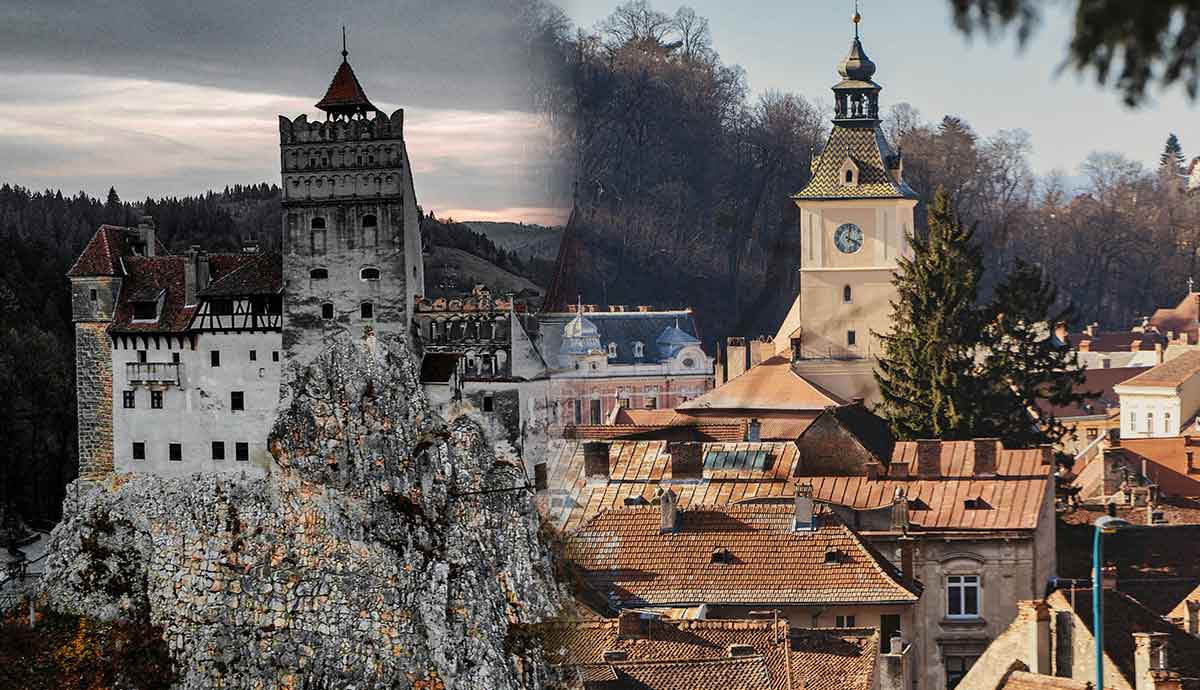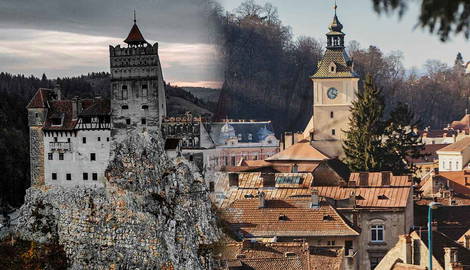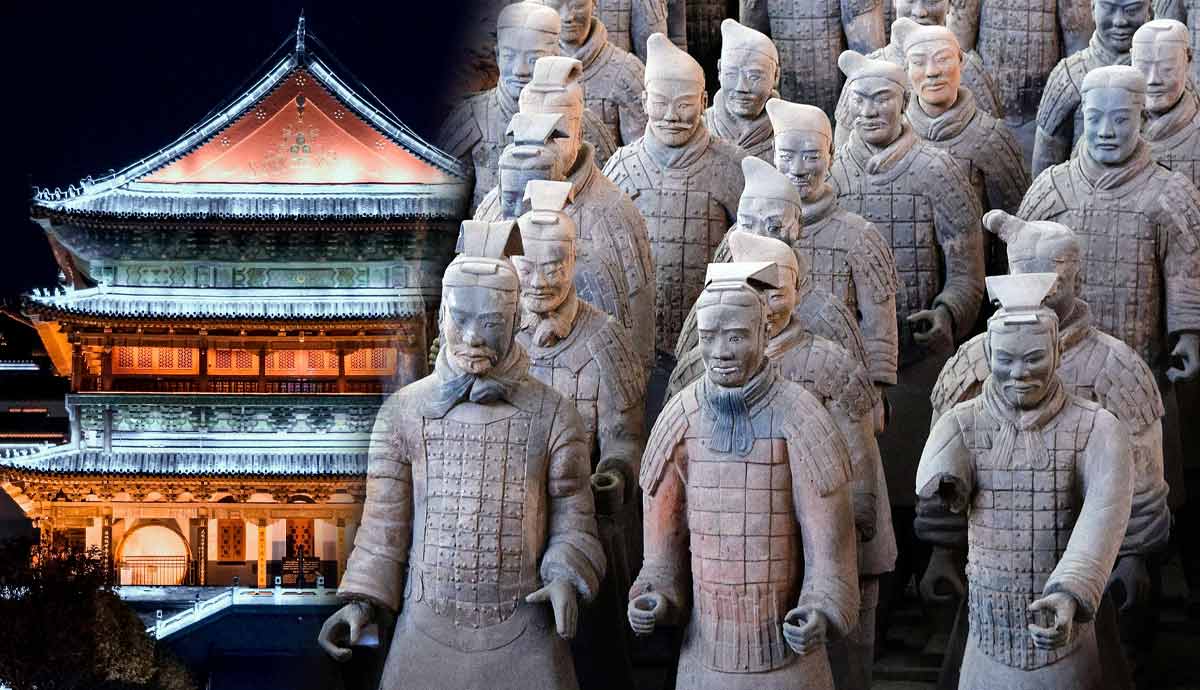
Romania is Europe’s 12th largest and 6th most populous country. The region, which features the Carpathian Mountains and Danube River, has been settled since the Lower Paleolithic. Over the centuries, Romania was part of the Roman, Ottoman, and Austro-Hungarian empires. Between 1946 and 1989, it was a socialist republic and it is currently a democratic country. Romania is part of the EU and hosts several UNESCO World Heritage Sites. Tourism in the country is growing, but it remains a great place to escape the crowds and experience something unique.
1. The Medieval City of Braşov

Braşov is a medieval town in Transylvania, situated among the stunning Southern Carpathian Mountains. It is 103 miles north of the nation’s capital, Bucharest. The earliest indication of human activity in the area can be traced back to Neolithic times (~9500 BCE), and archaeologists have identified traces of human settlement in many areas surrounding Braşov. However, it was the Transylvanian Saxons (mostly of German ethnicity) that were key in developing the city as it is today. They were invited by Hungarian kings to develop towns, cultivate the land, and build mines in the years between 1141 and 1300. The settlers engaged in trade and crafts, becoming wealthy and influential, and the area became an important trade hub along routes between Austria and Turkey.
The walled city was almost completely destroyed by a fire in 1689 and took several decades to rebuild. When Austria-Hungary collapsed, Transylvania, including Braşov, became part of the Romanian state. After WWII, many ethnic Germans were deported to the Soviet Union, and when Romania became a communist state, most of those who remained went to West Germany.

When visiting Braşov, the medieval old town is a must-see, including the market square, which has been in use since 1364. Visit the imposing 14th-century Black Church, Romania’s largest Gothic church. Other sights include Catherine’s Gate, the Braşov city wall, Saint Nicholas Basilica, and the Rupea Hilltop Fortress. A novelty in the city is “String Street,” which is said to be Europe’s narrowest street at four feet in width.
You can also climb or take the cable car up Tampa Mountain, which features the “Braşov” sign (similar to the famous Hollywood sign) and excellent views of the city. From here, visitors can make day trips to the nearby Bran Castle, Peleș Castle, and Rasnov Fortress.
2. The Birthplace of Dracula: Sighișoara

Sighișoara is a medieval town in central Romania, in the historic region of Transylvania. As of 2021, the town had only 23,927 residents, but it is a popular tourist destination. Of particular interest is the old town, which is a UNESCO World Heritage Site. The area was settled in the mid-12th century when the Transylvanian Saxons were invited to the region by Géza II, the King of Hungary at the time. Records indicate that there was a settlement in Sighișoara as early as 1191.
Sighișoara, located at the edge of Central Europe, was important both commercially and strategically for centuries. It was one of Transylvania’s key urban centers and the site of many important events. George I Rákóczi was elected as Prince of Transylvania and King of Hungary in Sighișoara in 1631.
The town was damaged during the 17th and 18th centuries due to fires, military occupation, and plagues. Following WWI, Sighișoara, along with the rest of Romania, was passed from Austria-Hungary to the Kingdom of Romania.

Visitors arriving in Sighișoara are greeted by the clock tower, which stands above the city, and rows of colorful houses. There are two parts to the town. The upper area, known as the citadel, is the medieval stronghold. The lower part of the town lies in a valley along the Târnava Mare River.
The town is also known for being the birthplace of Vlad Tepes, also known as Vlad the Impaler or Vlad Dracula. Vlad, one of the most important rulers in Wallachian history, was known for his brutality and was the inspiration for the name of Bram Stoker’s Count Dracula. Visitors to Sighișoara can visit Vlad’s birthplace, which nowadays contains a medieval-style restaurant.
3. The Town With Eyes: Sibiu

Sibiu is a city in south Transylvania, central Romania, that dates back to the early Middle Ages. Around 1147, German Saxon settlers arrived from the Kingdom of France and territories of the Holy Roman Empire. By the 14th century, Sibiu had established itself as an important center for trade. The area was taken by the Ottomans, who withdrew in 1699.
After that, Sibiu became the capital of the Principality of Transylvania. The city continued to prosper in the 18th and 19th centuries. The first Romanian-owned bank was established in Sibiu, and the city also became the Metropolitan seat of the Romanian Orthodox Church. Sibiu’s historic center is currently on the tentative list to become a UNESCO World Heritage Site.
By 1941, most of the city’s population was ethnically German, along with a large community of Romanians and some Hungarians. Between the 1950s and 1990, most Germans left the city, going to Austria and West Germany. Interestingly, the current President of Romania, Klaus Iohannis, is an ethnic German from Sibiu.

Visitors can visit Sibiu’s two main squares, aptly named Piața Mare (“Large Square”) and Piața Mică (“Small Square”). The old town is divided into the Upper Town and Lower Town. In the Upper Town, you can find the most well-known sites, including the Bridge of Lies, Sibiu Lutheran Cathedral, the Clock Tower, and the Holy Trinity Cathedral. The Lower Town is more nondescript but equally charming, with old homes, alleys, coffee shops, and restaurants.
Sibiu has a unique feature, called the “Eyes of Sibiu,” and has been nicknamed “the town with eyes.” This is because the roofs of the city’s homes appear to have eyes! Though there are legends that these “eyes” were added to frighten people, they are actually ventilation holes in the attics of the houses.
4. Dracula’s Transylvanian Castle

Bran Castle, a medieval castle in Romania’s Carpathian Mountains, was constructed in 1377. The region was settled by Teutonic Knights, a catholic religious order, in 1211. The Teutons built a fortress at Bran but were driven out of the area in 1226. Later, in 1377, Hungarian King Louis I permitted the Transylvanian Saxons of Brașov to build the castle, which was finished in 1388. The castle was built on a cliff with a view of the surrounding area. Customs activities were conducted there, and it was used as a fortress to watch for Ottoman invaders.
The castle would go on to trade hands numerous times. Notably, János Hunyadi, the governor of Transylvania defeated the Ottoman army at Bran Castle. The castle was bought by the Transylvanian Saxons in 1498, and it was held even after the conquest of the Hungarian capital in 1541. The Habsburgs gained control of the region in 1687, but the castle remained in Transylvanian ownership.
The castle was renovated several times over the years but fell into disrepair until it was turned over to Queen Marie of Greater Romania in 1920. She restored the castle and used it as a royal summer residence. Marie died in 1938, and her daughter, Princess Ileana, was forced out of the country in 1948 by the new communist regime. The communists turned the castle into a museum in 1956. Eventually, the Romanian government returned the castle to Ileana’s son in 2009, and the family now operates the castle as a museum.

Bran Castle is known as “Dracula’s Castle,” though Bram Stoker never made this association and never visited Transylvania. Fans of Dracula made this association based on descriptions of the castle in the novel. Additionally, Vlad Tepes, or Vlad the Impaler, the figure that is associated with Count Dracula, never ruled from Bran Castle. However, some sources state that Vlad was held prisoner at Bran Castle for a short time.
5. Traveling to Another World at Salina Turda

Located outside the city of Cluj Napoca in northwestern Romania, Salina Turda is one of the world’s oldest salt mines and is now a popular tourist attraction. Salt was extracted from this mine continuously from the Middle Ages. The first mentions of the mine go back to 1075 CE and salt extraction continued until the first half of the 20th century. It is said that the workers at the mine were all free people and that along with their salary, they received holiday gifts that included oxen, wine barrels, and bread. From 1840, due to changes in social and economic conditions, salt extraction was reduced. After World War I, salt extraction became a state monopoly, and eventually, the Turda Salt Mine was closed in 1932.
After the mine closed, many people forgot about it until it was used as an air raid shelter during World War II. It was later used as a cheese warehouse. In 1992, the site was reopened to the public as a halotherapy (salt therapy) center and tourist attraction.

In 2008, after an investment of €5,888,000, renovations in the salt mine began, and in 2010, it opened again to visitors. Old mining and salt transport equipment, well-preserved over the years, was put on display. Visitors now descend deep underground, through long tunnel walkways, and can visit various sections of the mine.
The inside of the mine features out-of-this-world views from various balconies. There is a bowling alley, mini golf, table tennis, pool tables, and a Ferris wheel. Perhaps most mesmerizing is the subterranean lake, where visitors can rent paddle boats and enjoy views of the cave’s towering ceilings. Though there are other mines open to visitors in Romania, Salina Turda is the largest and undoubtedly the most spectacular.
6. A Touch of Whimsy at Peleș Castle

Peleș Castle is a Neo-Renaissance palace in the town of Sinaia, in the Carpathian Mountains. The palace was built between 1873 and 1914 for King Carol I of Romania and was his summer residence during the late 19th century. The king visited the site of the castle in 1866 and fell in love with the scenery. A few years later, the crown bought roughly 1.9 square miles of land in the area and plans were made for the palace, along with royal stables, a hunting lodge, and guards’ chambers. They also constructed a power plant, making Peleș Castle the first castle in the world to be completely powered by locally produced electricity.
Selecting the design for the palace was an arduous process. The king rejected the first three designs because they were copies of palaces in Western Europe. A German architect, Johannes Schultz, presented an original design and ultimately won the contract. Additional components, including towers, were later added to the castle. Construction stretched between 1875 and 1914, slowing during the Romanian War of Independence against the Ottomans (1877-1878). In 1947, the communist government seized the property, opening the castle as a tourist attraction, before later closing it in 1975.

After the Romanian Revolution in 1989, Peleș Castle was re-established as a heritage site and opened again to the public. The elegant castle has 160 rooms and 30 bathrooms, along with an elevator. It covers 34,000 square feet and has rooms decorated according to different world cultures, including Turkish, Moorish, French, and Florentine.
Many impressive collections are on display here, including weapons, statues, paintings, gold, and silver. Located 30 miles from the city of Braşov and 77 miles from Bucharest, Peleș Castle can be easily visited as a day trip along with Bran Castle.
7. Crovin: A Castle Fit for a King

Corvin Castle is in Hunedoara, central-western Romania. Construction began on the Gothic-style castle in 1446, by order of John Hunyadi, the Voivode of Transylvania (Romania’s highest-ranking official). Previously, the structure had been a fortress constructed by Charles I of Hungary. After John Hunyadi passed in 1456, work on the castle slowed, resumed in 1458, and then stopped completely in 1480. At that time, it was recognized as one of Eastern Europe’s largest and most impressive structures.
During the 17th century, additions were made to the castle for military and aesthetic purposes, including two new towers. In 1854, a lightning strike caused a fire at Corvin Castle, and all of its wooden parts were destroyed. The castle was then neglected for decades before being restored. A feature of the castle that makes it unique is the “Nje Boisia” tower, a five-story structure built for military purposes that has several small openings for firearms. The tower is connected to the castle using a 100-foot suspended corridor built on pillars.

Today, visitors to the castle enter by walking across the drawbridge. The inside of the castle features a Knights’ Hall, which was used for feasts. There is a chapel, a council room, an inner courtyard, and over 50 rooms now decorated with medieval art and furniture. It also has a large dungeon with a torture chamber inside. There is a 94-foot well, which was dug into stone in the 15th century. According to local legends, the well was dug by three Turkish prisoners, who were promised freedom when the well was complete. The task took 15 years and 28 days.
When visiting the castle, hop on a bus to Deva, which is only 12 miles away and features the Deva Fortress.
8. Casino Constanța: An Abandoned Wonder

Perhaps the most unexpected site on this list is Casino Constanța. The casino, now empty, was opened overlooking the Black Sea in 1910. The structure was built in an Art Nouveau style and is in the historic Peninsulă District of the port city of Constanța. Over the years, there were three different casinos constructed in the district. The first structure, built in 1880, was made of wood and was considered to be a symbol of Constanța. It was almost entirely destroyed in a storm in 1891. The second casino was built nearby and opened in 1893. The current structure was designed by Daniel Renard and was open for 38 years, though with interruptions. Opinions on the casino were divided. While some admired the structure, others considered it gaudy and over-the-top.
During World War I, Casino Constanța was bombed by German and Bulgarian troops. In World War II, it was used as a makeshift hospital. In 1960, the building was given to the National Office of Tourism and was converted to a restaurant. It was renovated most recently between 1986 and 1988 but was closed and abandoned between 1990 and 2020 due to high operational expenses. Today, it is under construction.
The casino, designated by the Romanian Ministry of Culture and National Patrimony as a historic monument, draws tourists and was long considered one of Romania’s most beautiful abandoned spots.
9. Palace of Parliament: A Story of Megalomania

The Palace of Parliament in Bucharest is the world’s second-largest administrative building, second only to the Pentagon. The palace was constructed by Nicolae Ceaușescu, the president of Communist Romania. Though Ceaușescu was relatively well-liked initially, things changed following a visit to North Korea. Ceaușescu was inspired by both the personality cult of Kim Il Sung and the national transformation that had taken place there. He envisioned a palace where he could stand overlooking his subjects, who cheered for him while waving flags.
To construct his palace, Ceaușescu employed a team of around 700 architects and demolished 2.7 square miles of the historic city center, including an entire neighborhood, 37 factories, a monastery, and a hospital. Over 40,000 people were forced to move, losing their properties. As many as 100,000 workers, including forced laborers, were brought on to construct the palace, and work continued from 1984 to 1997. Many workers died during construction, with estimates ranging between 27 and thousands, and it is believed that some are buried beneath it.
The cost of building the palace equaled five years of the country’s budget, and Ceaușescu took on foreign debt to finance it. To pay back the loans, he introduced an extreme austerity policy.

The size of the building is hard to fathom—it covers nearly four million square feet and has 1,100 rooms. It has twelve floors, plus an additional eight floors underground, including a bunker. It is one of the world’s heaviest buildings and sinks by six mm annually. It houses the Romanian Parliament, the National Museum of Contemporary Art, the Museum of Communist Totalitarianism, the Museum of the Palace, and an international conference center. The palace is the most valuable administrative building in the world, valued at €4 billion in 2020.










